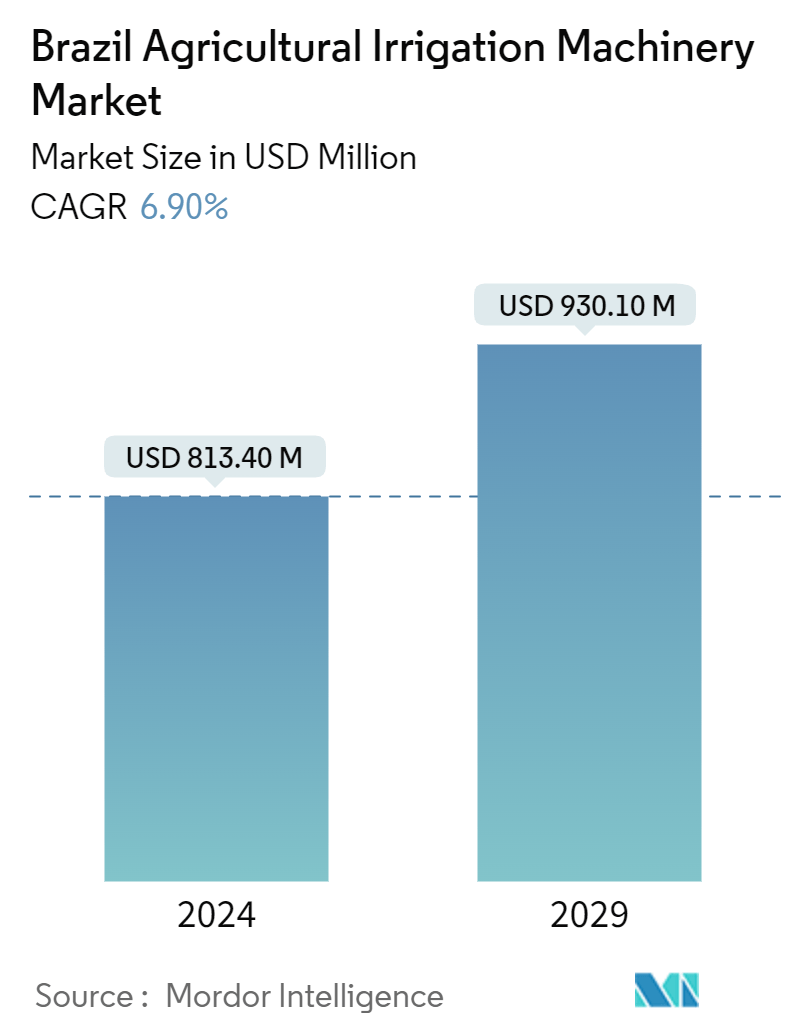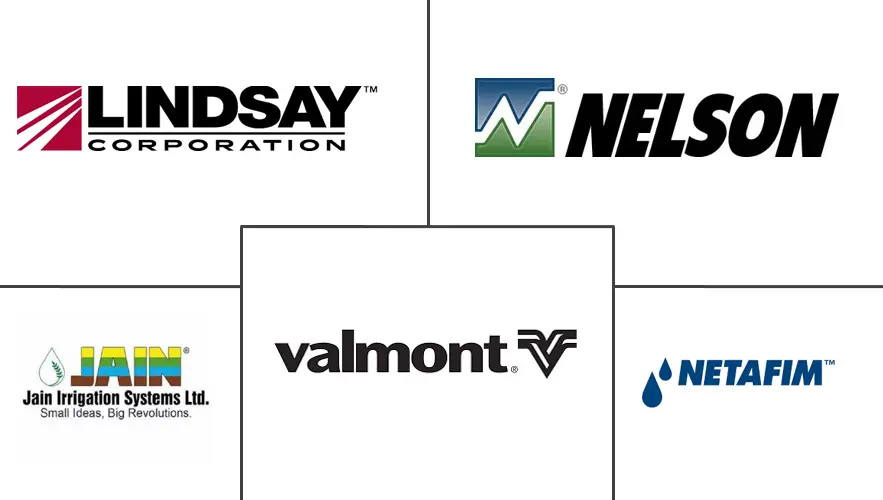Market Size of Brazil Agricultural Irrigation Machinery Industry

| Study Period | 2019 - 2029 |
| Base Year For Estimation | 2023 |
| Market Size (2024) | USD 813.40 Million |
| Market Size (2029) | USD 930.10 Million |
| CAGR (2024 - 2029) | 6.90 % |
| Market Concentration | High |
Major Players
*Disclaimer: Major Players sorted in no particular order |
Brazil Agricultural Irrigation Machinery Market Analysis
The Brazil Agricultural Irrigation Machinery Market size is estimated at USD 813.40 million in 2024, and is expected to reach USD 930.10 million by 2029, growing at a CAGR of 6.90% during the forecast period (2024-2029).
- Irrigation Machinery is effective in improving agricultural yields without consuming an excessive amount of water, preventing soil erosion and reducing water waste. Among various types of irrigation systems, drip irrigation is the most prevalent system in the country, whereas the pivot irrigation system is growing at the fastest pace. The fruits and vegetables segment is the leading segment utilizing irrigation systems.
- There has been an increasing adaptation of irrigation machinery in the country due to growing governmental concerns regarding water management for irrigation purposes, accompanied by the growing interest of stakeholders in accelerating production output. Also, irrigation machinery has been created to operate various crops, including orchard crops, cereals, and oilseeds. The use of drip and sprinkler irrigation systems in agriculture is growing. The trend of the increasing installation of irrigation systems in the country would continue, considering the popularity of Brazil-based fruits and vegetables in local and international markets.
- Further, the government has encouraged farmers to adopt automated machinery to enhance crop production. In 2021, Brazil launched its farm subsidies funding bill, called the 'crop plan' locally. The total budget for the program was increased by 6.1%, which accounted for USD 44.2 billion, and USD 10.6 billion of that is allocated for subsidized loans for agricultural systems. These initiatives encourage Brazilian farmers to adopt advanced irrigation equipment, including drip, for better crop production.
- The international authorities also have leaned financial support to boost smart agricultural techniques in Brazil, which has also favored the growth of drip irrigation. For instance, in 2022, IFC, a member of the World Bank Group, supported the renewal of sugarcane plantations, utilizing innovative and climate-smart agricultural techniques to mitigate climate risks with a financial package of USD 50 million. The program relies on implementing efficient micro-irrigation systems, including drip irrigation systems.
Brazil Agricultural Irrigation Machinery Industry Segmentation
Agricultural irrigation machinery is specified equipment and systems proposed to deliver water to agricultural fields and crops efficiently.
The Brazilian agricultural irrigation machinery market is segmented by type (sprinkler irrigation (pumping unit, tubing, couplers, spray/sprinklers heads, and fittings and accessories), drip irrigation (valves, backflow preventers, pressure regulators, filters, emitters, tubing, and other drip irrigation systems), and pivot irrigation) and application (crop type and non-crop type). The report offers the market size and forecasts regarding value (USD) for all the above segments.
| Type | |||||||||
| |||||||||
| |||||||||
| Pivot Irrigation |
| Application | |||||
| |||||
|
Brazil Agricultural Irrigation Machinery Market Size Summary
The Brazilian agricultural irrigation machinery market is experiencing significant growth, driven by the country's extensive use of various irrigation methods to enhance agricultural productivity. Brazil ranks among the top ten countries globally in terms of irrigated areas, with millions of hectares dedicated to food production through techniques such as surface, sprinkler, localized, and subterranean irrigation. Despite concerns over water usage, these methods have proven beneficial in increasing crop yields and reducing costs. The drip irrigation segment, in particular, is expected to see substantial growth, as it has demonstrated superior efficiency in water use without compromising crop output. This is especially relevant for major crops like coffee and bananas, where improved irrigation systems have led to better water management and enhanced agricultural productivity.
The market is characterized by a consolidation of major manufacturers, with international companies leading due to their reputation for quality and comprehensive after-sales support. The push for water conservation is further propelling the adoption of micro-irrigation systems, which are anticipated to experience robust growth. This trend is expected to benefit key players in the industry, such as Nelson Irrigation, Netafim, Jain Irrigation Systems Ltd., Valmont Industries, and Lindsay Corporation. These companies are well-positioned to capitalize on the increasing demand for efficient irrigation solutions, which are crucial for optimizing water use and boosting agricultural output in Brazil.
Brazil Agricultural Irrigation Machinery Market Size - Table of Contents
-
1. MARKET DYNAMICS
-
1.1 Market Overview
-
1.2 Market Drivers
-
1.2.1 Rising Problem of Water Scarcity in Brazil
-
1.2.2 Increasing Agricultural Output is Driving the Adoption of Irrigation Machinery
-
1.2.3 Government Initiatives Fuel Growth in the Brazilian Irrigation Systems Market
-
-
1.3 Market Restraints
-
1.3.1 Damage Caused to Irrigation System Set-up Due to Hard Water Supply in Brazil
-
1.3.2 High Initial Capital Investments
-
-
1.4 Porter's Five Forces Analysis
-
1.4.1 Threat of New Entrants
-
1.4.2 Bargaining Power of Buyers/Consumers
-
1.4.3 Bargaining Power of Suppliers
-
1.4.4 Threat of Substitute Products
-
1.4.5 Intensity of Competitive Rivalry
-
-
-
2. MARKET SEGMENTATION
-
2.1 Type
-
2.1.1 Sprinkler Irrigation
-
2.1.1.1 Pumping Unit
-
2.1.1.2 Tubing
-
2.1.1.3 Couplers
-
2.1.1.4 Spray/Sprinklers Heads
-
2.1.1.5 Fittings and Accessories
-
-
2.1.2 Drip Irrigation
-
2.1.2.1 Valves
-
2.1.2.2 Backflow Preventers
-
2.1.2.3 Pressure Regulators
-
2.1.2.4 Filters
-
2.1.2.5 Emitters
-
2.1.2.6 Tubing
-
2.1.2.7 Other Drip Irrigation Systems
-
-
2.1.3 Pivot Irrigation
-
-
2.2 Application
-
2.2.1 Crop
-
2.2.1.1 Field Crops
-
2.2.1.2 Vegetables
-
2.2.1.3 Fruits
-
-
2.2.2 Non-crop
-
2.2.2.1 Turf and Ornamental
-
-
-
Brazil Agricultural Irrigation Machinery Market Size FAQs
How big is the Brazil Agricultural Irrigation Machinery Market?
The Brazil Agricultural Irrigation Machinery Market size is expected to reach USD 813.40 million in 2024 and grow at a CAGR of 6.90% to reach USD 930.10 million by 2029.
What is the current Brazil Agricultural Irrigation Machinery Market size?
In 2024, the Brazil Agricultural Irrigation Machinery Market size is expected to reach USD 813.40 million.

